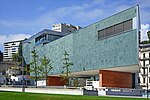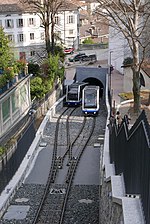Eurovision Song Contest 1956

The Eurovision Song Contest 1956 was the first edition of the annual Eurovision Song Contest, organised by the European Broadcasting Union (EBU) and host broadcasters the Swiss Broadcasting Corporation (SRG SSR) and Radiotelevisione svizzera (RSI). The contest, originally titled the Grand Prix Eurovision de la Chanson Européenne 1956 (Italian: Gran Premio Eurovisione 1956 della Canzone Europea, English: Grand Prix of the Eurovision Song Competition), was held on Thursday 24 May 1956 at the Teatro Kursaal in Lugano, Switzerland, and hosted by Swiss television presenter Lohengrin Filipello, which remains the only time that the contest has been hosted by a solo male presenter. Inspired principally by the Italian Sanremo Music Festival, held annually since 1951, the concept of a televised European song contest, initially proposed by Italian broadcaster RAI, was formulated by an EBU committee led by Swiss broadcaster and executive Marcel Bezençon. Following approval at the EBU's General Assembly in 1955, the rules and structure of the contest were agreed upon. Several of the rules utilised in this first contest would subsequently be altered for future editions, and it remains the only edition in which each country was represented by two songs, with only solo performers allowed to compete, and a voting process which was held in secret and where juries could vote for the entries from their own country. Seven countries participated in the inaugural edition of the contest, and the first winner was the host country Switzerland, with the song "Refrain" performed by Lys Assia. The result was determined by an assembled jury composed of two jurors from each country, with each juror ranking each song between 1 and 10 points. Only the winning country and song were announced at the conclusion of the event, with the results of the remaining participants unknown. Even though it was broadcast on television and radio via the Eurovision network in ten countries, no video footage of the event is known to exist, with the only video available being of the reprise performance from an independent archiver; the majority of the broadcast is, however, available in audio.
Excerpt from the Wikipedia article Eurovision Song Contest 1956 (License: CC BY-SA 3.0, Authors, Images).Eurovision Song Contest 1956
Riva Vincenzo Vela, Circolo di Lugano ovest
Geographical coordinates (GPS) Address Nearby Places Show on map
Geographical coordinates (GPS)
| Latitude | Longitude |
|---|---|
| N 46 ° | E 8.95 ° |
Address
Boatcenter Lugano
Riva Vincenzo Vela
6902 Circolo di Lugano ovest
Ticino, Switzerland
Open on Google Maps









